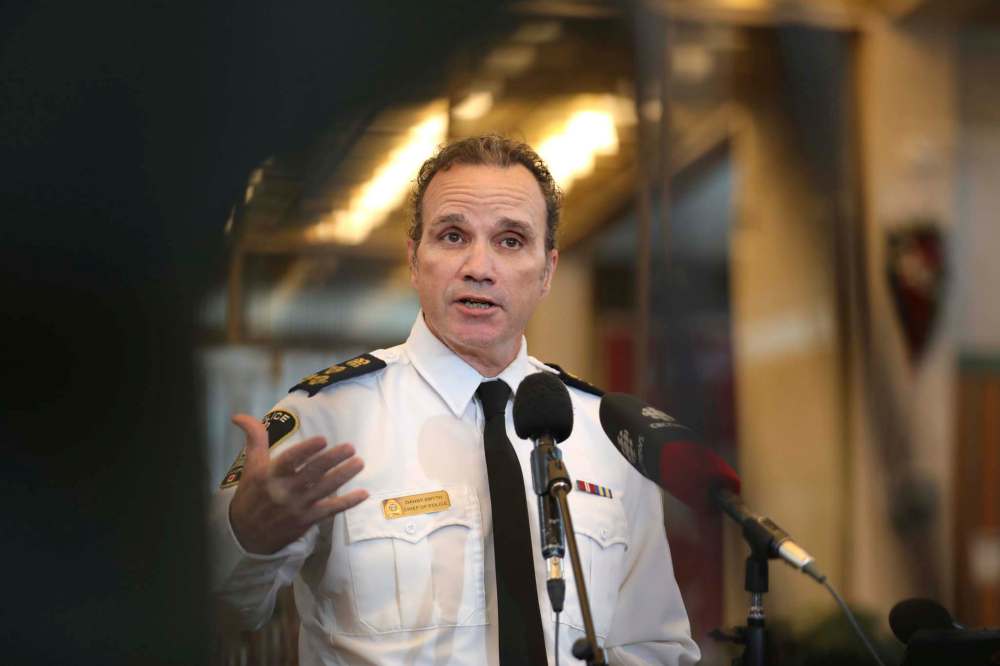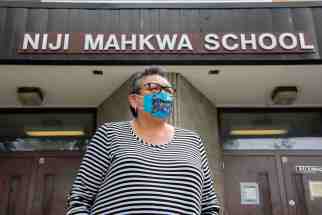Clear policy needed for police body cameras
Read this article for free:
or
Already have an account? Log in here »
To continue reading, please subscribe:
Monthly Digital Subscription
$0 for the first 4 weeks*
- Enjoy unlimited reading on winnipegfreepress.com
- Read the E-Edition, our digital replica newspaper
- Access News Break, our award-winning app
- Play interactive puzzles
*No charge for 4 weeks then price increases to the regular rate of $19.00 plus GST every four weeks. Offer available to new and qualified returning subscribers only. Cancel any time.
Monthly Digital Subscription
$4.75/week*
- Enjoy unlimited reading on winnipegfreepress.com
- Read the E-Edition, our digital replica newspaper
- Access News Break, our award-winning app
- Play interactive puzzles
*Billed as $19 plus GST every four weeks. Cancel any time.
To continue reading, please subscribe:
Add Free Press access to your Brandon Sun subscription for only an additional
$1 for the first 4 weeks*
*Your next subscription payment will increase by $1.00 and you will be charged $16.99 plus GST for four weeks. After four weeks, your payment will increase to $23.99 plus GST every four weeks.
Read unlimited articles for free today:
or
Already have an account? Log in here »
Hey there, time traveller!
This article was published 08/06/2021 (1648 days ago), so information in it may no longer be current.
Approval of city funding to equip Winnipeg police officers with body-worn cameras should only come with strings attached. In particular, police should clearly outline what policies will govern the use of the cameras and the subsequent footage to avoid the mistakes of other police forces.
The Winnipeg Police Board last week approved a request from Winnipeg Police Service Chief Danny Smyth to consider a $32-million, multi-year proposal to add body-worn cameras for front-line officers. The chief’s position is that the cameras would increase police transparency and accountability by providing a visual record of officer interactions with the public.
Winnipeg police need to be more accountable; no argument there. This city has recently experienced nothing less than a social uprising against police, with organized groups and large protests speaking against systemic racism and demanding change that ranges from more effective prosecution of rule-breaking officers to defunding the force.

This is the context in which the police chief has resurrected the appeal for body cameras that the force first made 10 years ago. Council might be more inclined to favour the rather costly proposal this time around, considering the widely expressed distrust of Winnipeg police and, perhaps, the high-profile role that camera footage played in the ongoing prosecution of Minneapolis police officers in the death of George Floyd.
But councillors should hit pause on the camera proposal until it examines the experience of other cities, including several in Canada. Calgary has had them since 2019, all front-line Toronto officers will wear them beginning in October, the RCMP is introducing them at 700 detachments over five years, and police in many U.S. cities already have them.
Unfortunately, scholarly studies suggest cameras don’t always achieve the stated police goals. A September 2020 study of evidence from 30 U.S. cities did not find strong support that the devices increased police transparency and accountability.
One serious problem was that some U.S. police forces hire public-relations firms with broadcast-news expertise to edit the raw police-camera footage into compelling segments that are then distributed to media. Often, the footage is edited to support the police version of encounters.
Who has access to the footage and how the footage is used are crucial questions that should be publicly addressed by any police force sincerely interested in transparency. It’s concerning that many forces refuse to publicly disclose their body-cameras policies. A U.S. human-rights organization called The Leadership Conference on Civil and Human Rights analyzed body-camera policies for 75 major law enforcement agencies in the U.S., finding about one-third of police services don’t make their body-camera policies available to the public.
Winnipeg city council shouldn’t approve the chief’s request without a draft of the policies that would govern the cameras. For starters, the policy should outline when front-line officers can deactivate their cameras, when footage can be edited or destroyed, what access victims of crime will have to the unedited footage, and whether the footage will be controlled by police or by an independent third-party.One serious problem was that some U.S. police forces hire public-relations firms with broadcast-news expertise to edit the raw police-camera footage into compelling segments that are then distributed to media. Often, the footage is edited to support the police version of encounters.
If Mr. Smyth is sincere in seeking transparency and accountability, he will commit to publicly posting on a website the force’s body-camera policies, and will agree that the enforcement of these policies must be overseen by an independent authority.
Without such guarantees of public accountability, it might appear police want the cameras as a technological tool to manipulate their public image. In that case, so much for transparency.










